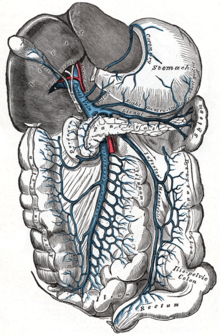Situs
Situs (from the Latin situs "position") is a medical term with different meanings depending on the context.
anatomy
In topographical anatomy, a situs is usually the relationship between the internal organs .
The usual position of the internal organs is called the situs solitus .
In contrast to the normal situation, the situs inversus totalis , or situs inversus for short , denotes a mirror-inverted position of all internal organs, which normally does not have any adverse effects on health.
In a situs inversus partialis ( heterotaxy ), only part of the internal organs are shifted to the opposite side. Since there are many possibilities for such a right-left exchange, it is a characteristic of various diseases.
A situs inversus ambiguus , situs ambiguus for short , is used on the one hand when components of the situs solitus and the situs inversus can be found in a person . This definition corresponds to that of the situs inversus partialis.
On the other hand, by a situs inversus ambiguus speaking, if normally the side ( laterally ) lying organs are displaced toward the center of the body. Here, too, various clinical pictures occur.
Obstetrics
In obstetrics , the position of the fetus in the uterus (skull, pelvic, transverse or oblique position) is called the situs; it is a component of the child's position . The position of the fetus can be determined by both the gynecologist and the midwife .
surgery

The surgical language usage differs. There, the opened surgical area is called the situs. In particular, is in minimally invasive keyhole surgery any intervention, the exact knowledge of before Situs essential.
literature
- Pschyrembel Clinical Dictionary 2014 . 265th, revised edition, de Gruyter, Berlin 2013, ISBN 978-3-11-030509-8 .
Individual evidence
- ^ Scientific advice of the Duden editorial team (ed.): Duden, German Universal Dictionary. 6th edition, Dudenverlag, Mannheim / Leipzig / Vienna / Zurich 2007, ISBN 978-3-411-05506-7 , p. 1549.
- ↑ Nicole Silbermann: Why does some people's heart beat on the right? In: Welt Online. dated July 18, 2002, ISSN 0173-8437 , last accessed on June 8, 2016.
- ↑ a b Soo-Jin Kim: Heterotaxy Syndrome. In: Korean Circulation Journal. (Korean Circ J) May 2011, Volume 41, No. 5, pp. 227-232, doi: 10.4070 / kcj.2011.41.5.227 .
- ↑ Jae-Gyung Kim, Ho-Joong Youn, Gee-Hee Kim, and others. a .: Incidentally Detected Situs Ambiguous in Adults. In: Journal of Cardiovasc Ultrasound. (J Cardiovasc Ultrasound.) December 2011, Volume 19, No. 4, pp. 211-215, doi: 10.4250 / jcu.2011.19.4.211 .
- ^ JP Jacobs, RH Anderson, PM Weinberg: The nomenclature, definition and classification of cardiac structures in the setting of heterotaxy. In: Cardiology in the young. (Cardiol Young) September 2007, Volume 17, Supplement S 4, pp. 1-28, doi: 10.1017 / S1047951107001138 .
